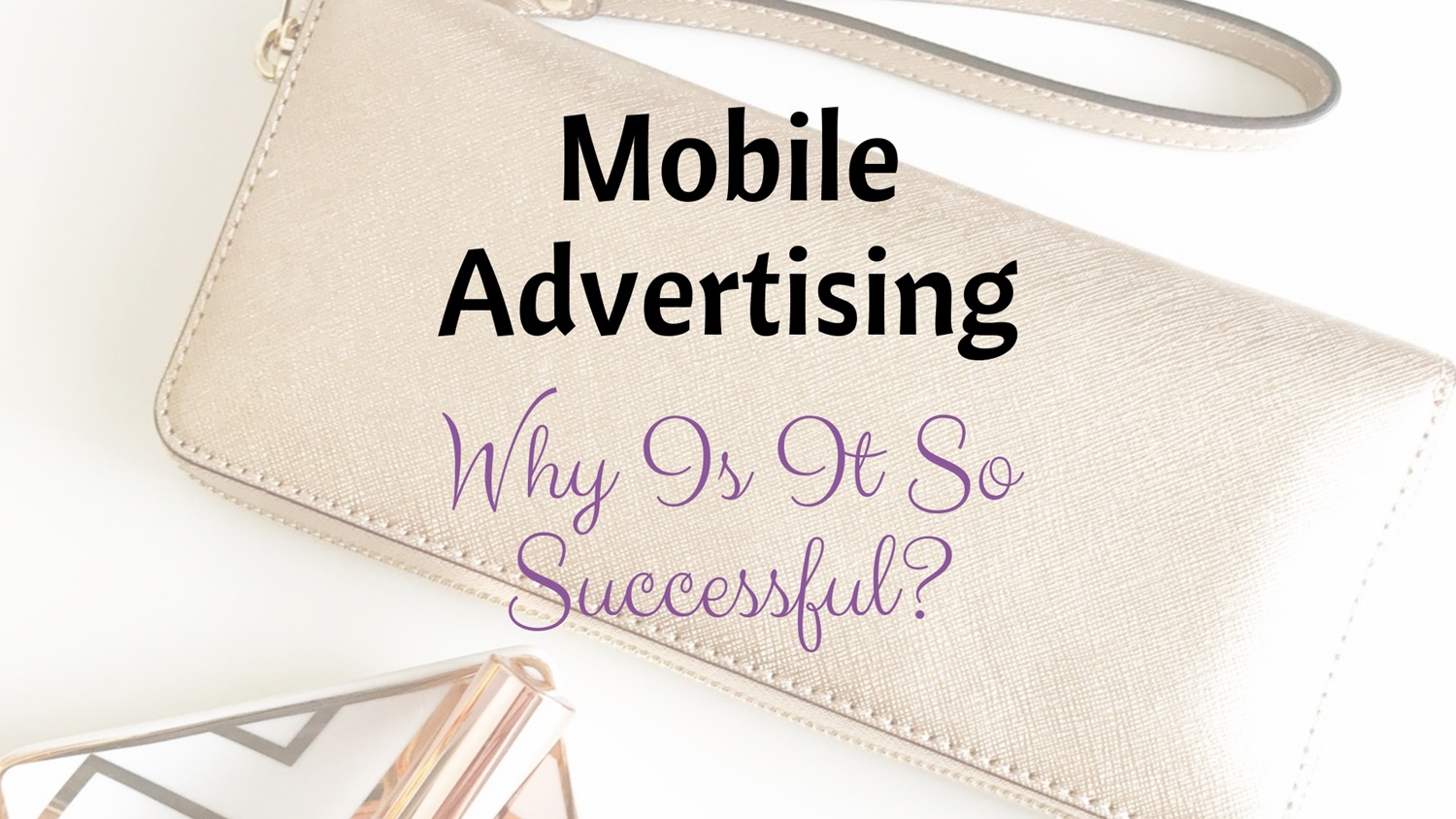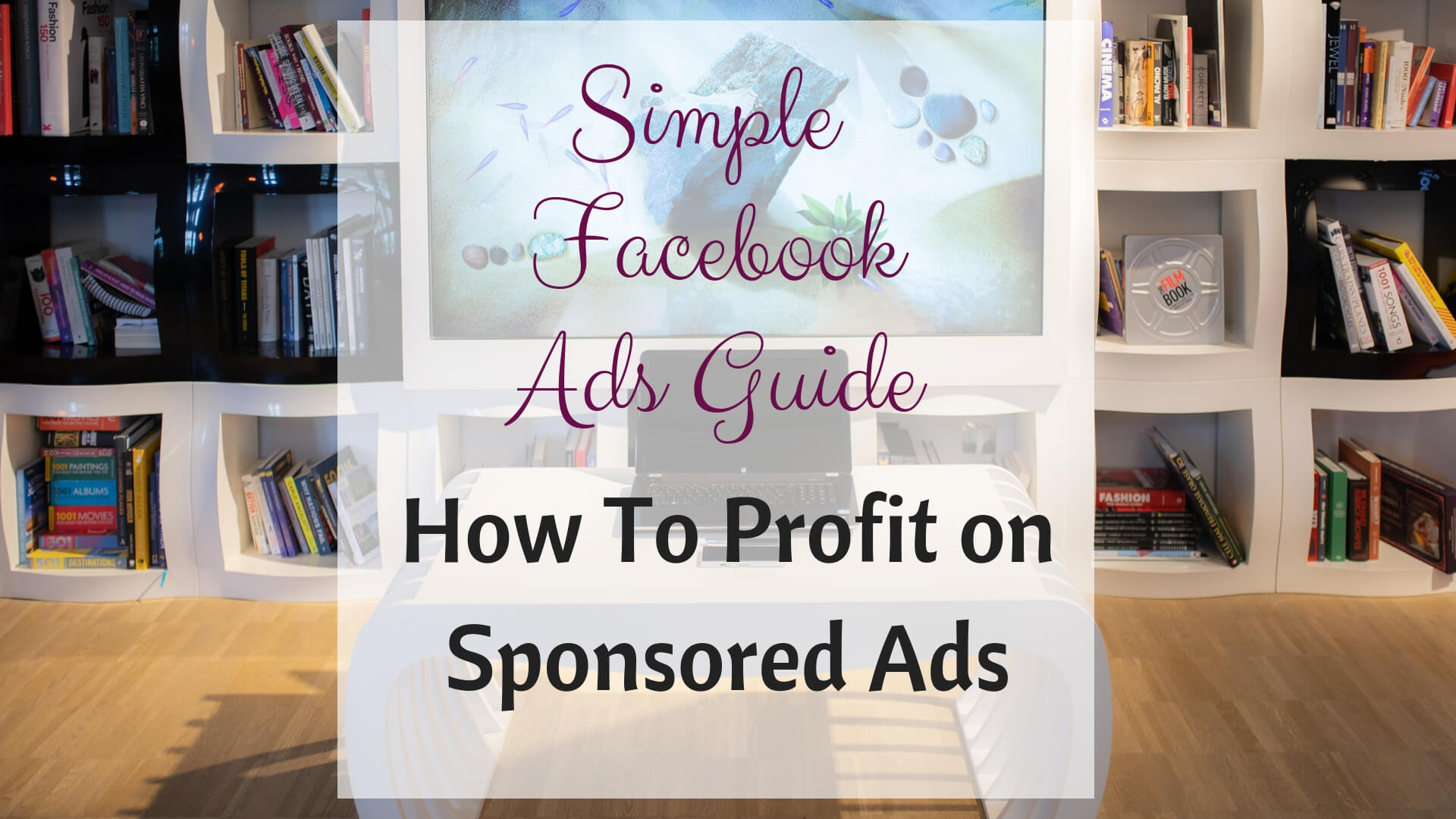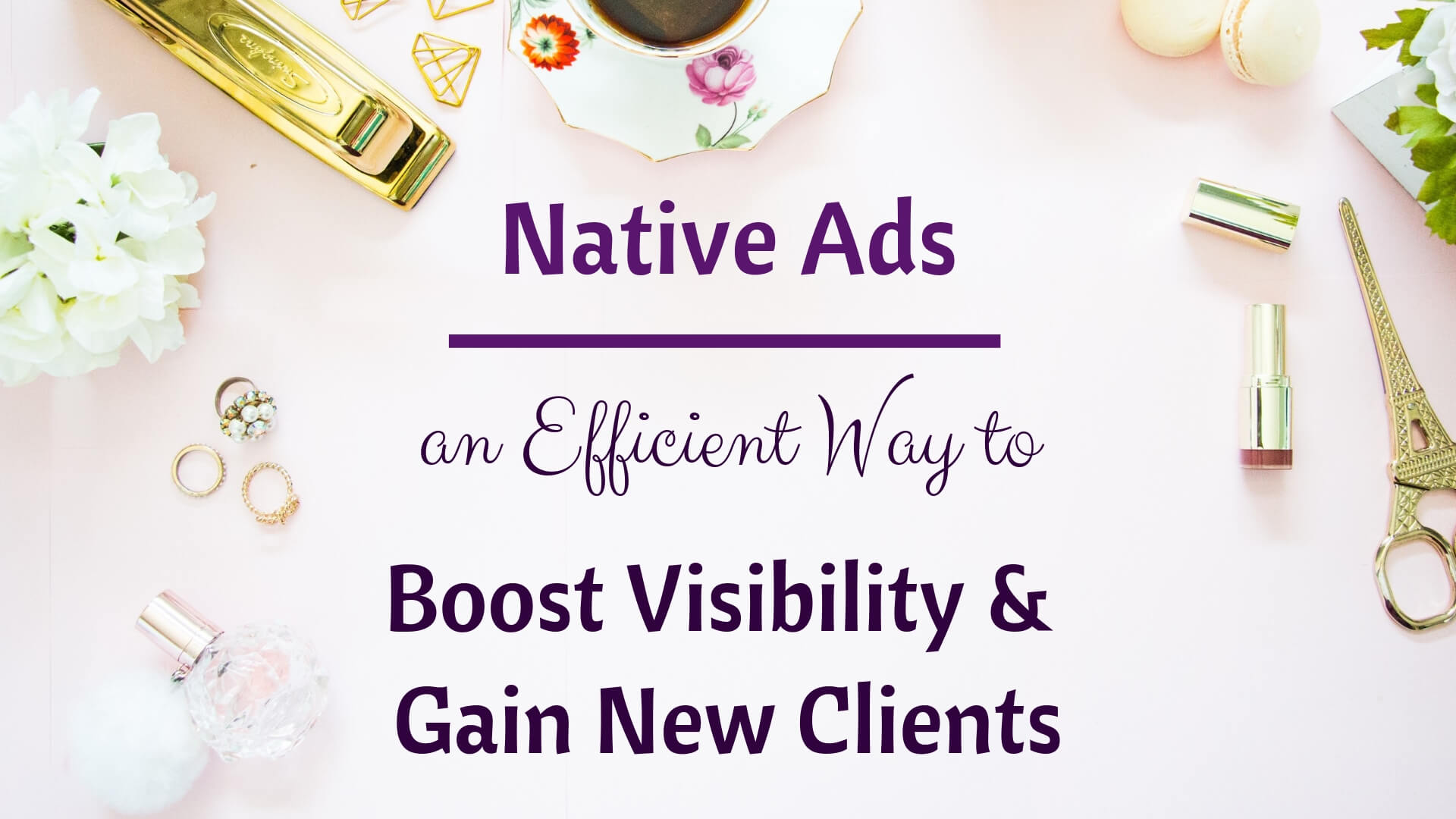All businesses need constantly new leads and new clients. In our digital century, this is done through free-generated traffic and paid traffic. When referring to paid traffic Google AdWords Search Network and Google AdWords Display Advertising are among the main actors. This article is a Google Display Ads tutorial that will discuss how to set up Google Display Ads in detail.
But first, let’s clarify the above-mentioned notions:
Google AdWords Search Network: These are the ads that appear on top of a search engine results page and have the case “ad” in front of them. Within AdWords Search Network you bid on keywords for a limited number of ad spots. Consequently, the competition for a certain keyword may raise your ad costs quite fast.
Let’s Make Your SEO & Content Work Better for Your Business
Google AdWords Display Advertising: These are ads that are shown on different sites and pages across the web. This option offers a multitude of ad spaces, in various formats and types, combined with different targeting options to reach local or global audiences. Practically any site can register itself into Google AdSense and offer space for ads in exchange for a commission. Google AdWords Display uses the space in Google AdSense to promote ads.
To have an idea of the size and reach that the Google Display Network can achieve, take into consideration that about 3 million sites are registered to AdSense and covers 90% of Internet users.
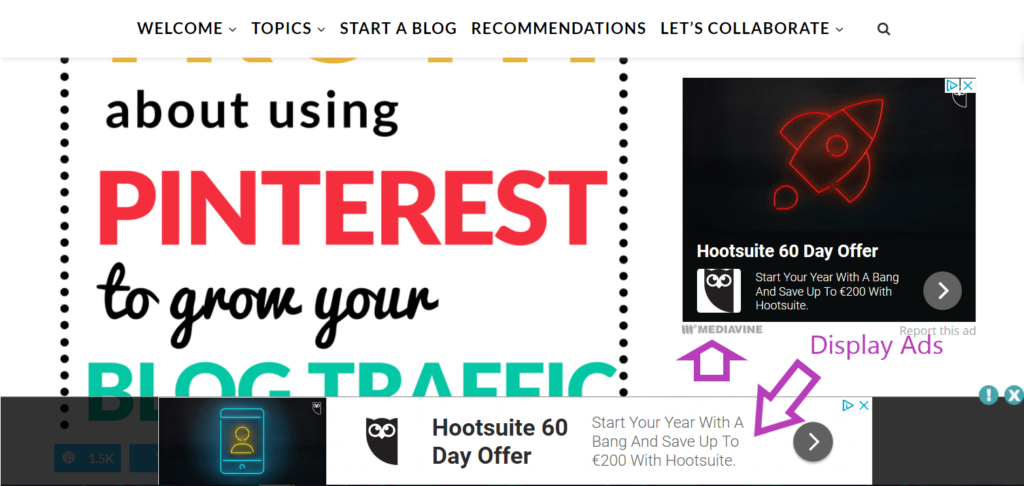
The key difference between Google Search Network and Google Display Network is that in the second case, users are not actively searching for a product or a service. Displaying ads on Google Display Network is, in fact, “interruption marketing”, as it is introduced while the prospect is surfing the Internet.
Because of this difference, you have to employ different campaigns to target each network. So, you need to have a campaign targeting the AdWords Display Network and another campaign targeting the AdWords Search Network!
To maximize the efficiency of your ads budget, you need to have a clear understanding of how to use correctly the Google Display Network. The abilities of targeting and segmenting offer a high lucrative potential for advertisers.
Along the time Google AdWords evolved from the search advertising platform to Gmail, video, search partners and display.

Visuals are the first vector of sales.
Use Professional Styled Stock Photography to Promote Your Business.
Google Display Ads Tutorial: The Basics
Types of Adverts
Google Display Network offers several formats for adverts and a handful of sizes. The types of ads you can create through Google Display Network are:
* Text Ads – these are composed exclusively of text, one headline, a maximum of two lines of text and a URL. Text ads are very similar to those of the search network. You have also the possibility to test more versions of text ads to see which generates more results.
* Image Ads present a static image that can be customized with background colors and types of layouts. The image ad will occupy the entire ad block.
* Video Ads are trending, as video content is gaining momentum and YouTube is a participant in the Display Network. As a consequence, you have the possibility to have ads displayed on YouTube videos.
* Rich Media Ads – comprise interactive elements, like animations or carousels of products. The interactive elements change based on the user’s interaction with the ad and the characteristics of his profile.
Google Display Ads Sizes
You have many options to choose from: simple images or animated, or HTML5 ads in a variety of sizes as listed here. The formats supported are .jpg., .gif, .png, .zip and .swf and the image should not be larger than 150KB.
Taking into consideration that each site participant in Google AdSense will define the ad block size that it hosts, you should consider creating ads of different sizes to fit in the various ad block options. This is a prerequisite to avoid having your ads limited from exposure on certain sites because you don’t have the right dimension ad to fit the respective ad block.
In general, rich media or image ads will have a better click-through rate but will be displayed less. Also, you need to be aware of the fact that in an ad block, just one image ad fits, meanwhile, text ads may be able to share the block. Hence while displaying image ads you have to outbid the combined cost of the text ads.
Google Display Ads Tutorial: Define What Is the Potential of Your Ads Profitability
Before starting to create a display campaign, you should verify which is its potential to generate profit. Check up on the following:
Offer
Decide which products/services you want to advertise. It’s better to start with your most thought service or product, as this is your best chance to see profit rapidly.
Capacity
Establish how many products or services you can provide in a certain period, based on your resources. If you provide coaching sessions, for instance, you have a limited time for that. If you produce a product like cakes you have a certain capacity to produce and deliver. You do not want to have more requests than you can handle, so, adjust your ad spending accordingly.
Cost and profit estimation
Check your numbers first, see how much will cost the acquisition of a new client using ads and compare it with your profit per customer. If your estimated cost is larger than the potential profit you can generate, paid ads are not an option.
Decide on Target Buyer Persona
If your ads campaign has enough potential for profit, the next step is to decide the buyer persona, the ideal client that will be the target of this campaign. In principle, you should have the buyer personas defined in your marketing strategy. To perfectly target your ads campaign, you need the buyer persona that you want to focus on.
Your business might have several buyer personas, defined by demographic elements, problems they try to solve and motifs that generate the need for your product or service. The customer avatar will help you further in building the optimum ads campaign. For your buyer persona establish the following details:
* Which is the problem they want to solve?
* Why do they need a solution to this problem?
* Why is your product/service the best solution?
* Which is the offer that can entice them to act and buy?
The buyer persona is the foundation of the targeting activity while building an ads campaign. And the success of your campaign relies heavily on proper targeting.
Google Display Ads Tutorial: Targeting on the Display Network
When building your ads campaign, you are directly interested to have your ad shown to the persons that are most interested and more likely to buy your products/services. That translates into proper targeting, which can be achieved via:
Placement Targeting
Placement targeting allows you to choose the sites on which your ads will be displayed. This option is effective for filtering a certain demographic element or a specific interest that is relevant to the target audience.
If you identify industry-specific sites or forums whose audience is likely to be interested in your offer, you should pick those as placement for advertising. To find out which sites Google considers relevant for your keywords and where you should display your ads, check AdWords Display Planner.
To obtain the placements just search for the target keyword and click the tab “Get placement ideas”:
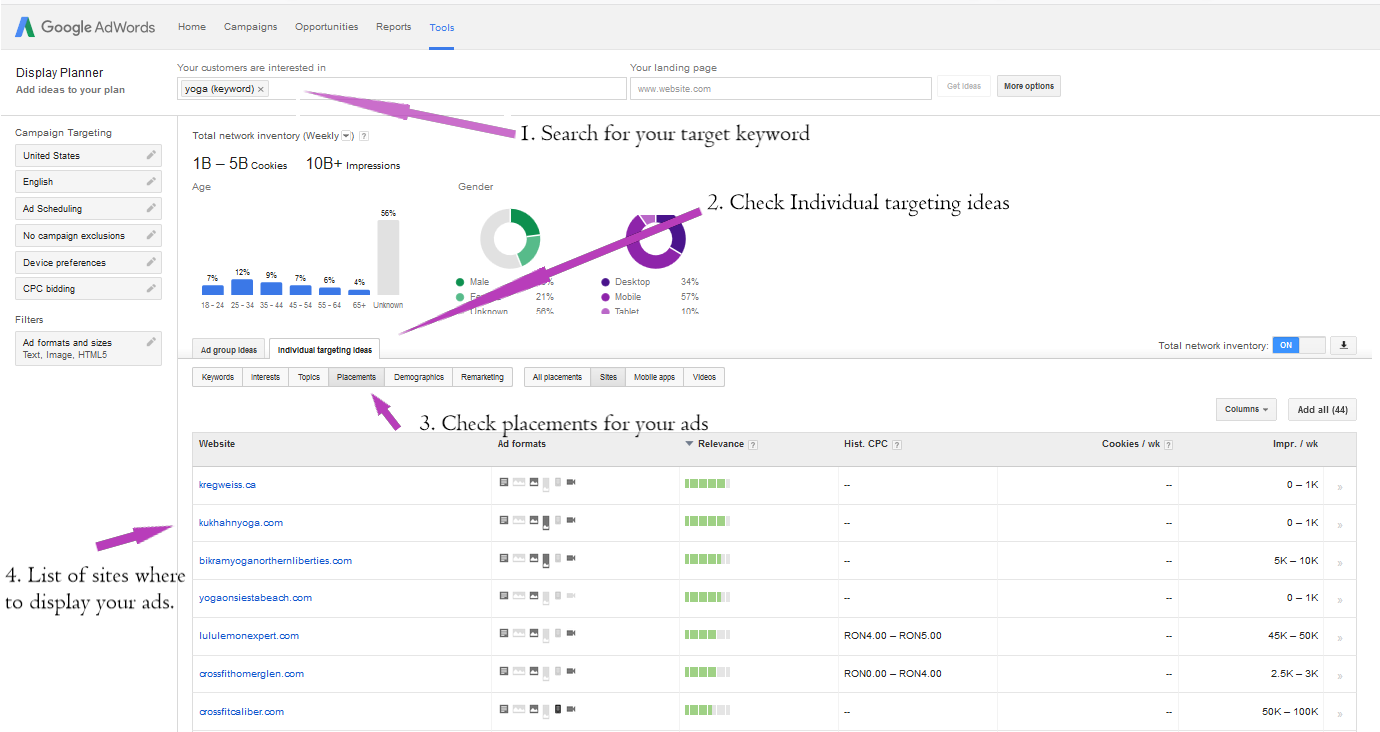
After you get this list, check each site and you will access information concerning demographics, ad inventory and formats. Then decide if the respective site is a good fit for your target buyer persona.
Demographic Targeting
Based on your buyer persona characteristics you can filter the target of your ads based on gender, age, income, civil status, etc. And have the possibility to exclude categories that do not fit your buyer personas. If you sell bras, for instance, you can confidently exclude men from your targeting.
Contextual Targeting
Contextual targeting is the primary targeting option as it is based on keywords associated with your offer. So, you have to write a list of 5-15 words or long tail keywords relevant to the purpose of your ads. Subsequently, Google will display your ads on sites related to your keywords.
Constantly verify the sites where your ads appear and adjust your keyword list in concordance. To obtain this info check the “Placements” section.
Topic Targeting
Topic targeting offers the possibility to select the topics of the pages where your ads will be displayed.
The problem with topic targeting is that you cannot refine too much the topics, they are just very general. For example, a topic is “Marketing” and you may be interested just in content marketing or strategic marketing. Hence, the best way is to combine different targeting methods, to ensure your campaign is highly targeted.
Audience Targeting
Audience targeting is realized upon two different criteria interest and remarketing.
The targeting based on interest refers to the browsing history of a person, if she visited repeatedly a certain site, Google concludes she has an interest in that area. If a user is visiting several times voyage and travel sites, the conclusion is that the respective person has an interest in travelling. This method is different as it targets the user, not the site he is visiting.
Remarketing targets only former visitors to your site. Using the cookies placed on the connected devices of your site users, Google is able to subsequently display your ads when these users are visiting other sites as part of the Display Network. Remarketing offers several options from simply targeting anyone who visited your site, to more advanced ones like targeting just persons that took a certain action on your site or remained a certain amount of time.
Obviously combining two or more targeting options is likely to bring you better results, because of highly effective targeting. The number of potential impressions will decrease, but your ad will be shown only to persons that match all your criteria.
Once the basics are defined, let’s pass to effectively creating your campaign.
Keep reading!
Google Display Ads Tutorial: Create a Compelling Offer
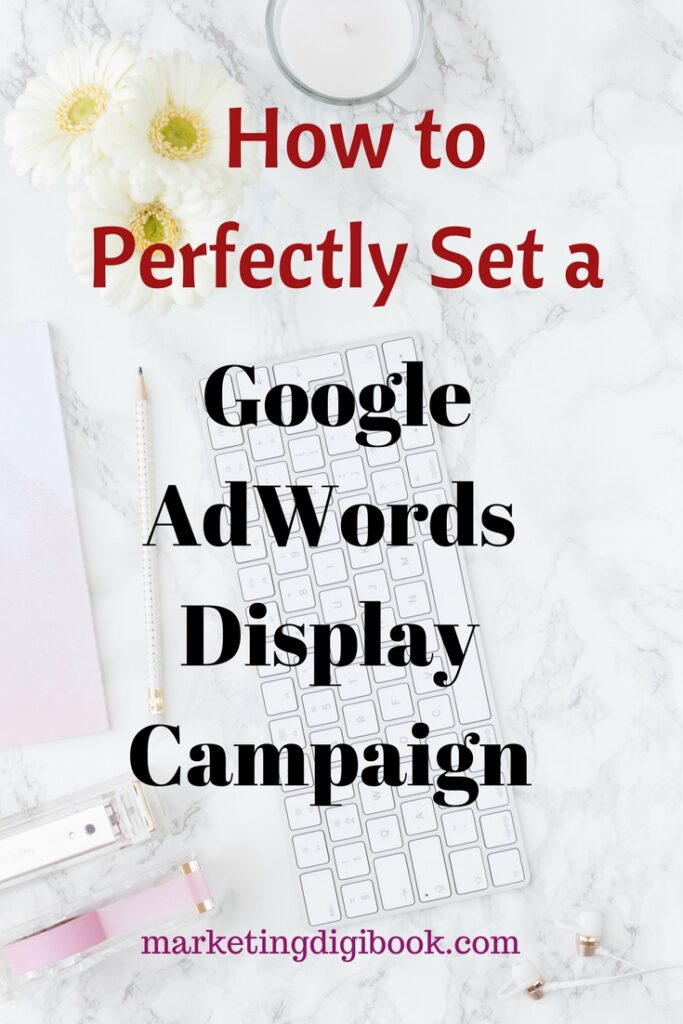
Since on Google Ads Display Network the prospects are not actively looking to buy or searching for products or services, your ads need to capture the attention, pop-up, be very relevant, promise an irresistible offer and include a powerful call to action.
Some offers that can entice prospects are:
· First-time discounted offers
· Compelling free guides, ebooks, and case studies
· Free consultations
· Extended guarantees
· Additional gifts on purchase
Google Display Ads Tutorial: Craft Mesmeric Ads
The next step is to create the ads that will serve your initially stated purpose, clicks and new traffic to your site, or new leads and potential customers.
When creating your ads, you should concentrate on two directions:
· To attract your buyer persona and to encourage her to take the desired action
· To discourage not qualified viewers to click on your ads and waste your budget
Keeping in mind the above-mentioned desiderata here are the core components of your ads:
· Significance for your buyer persona. The copy of your ad should be relevant to the characteristics of your buyer persona in order to attract her attention.
· A substantial and irresistible offer. Your offer should highlight and emphasize the benefits that your customer will have for using your products/services.
· An enticing and powerful call to action. After attracting the attention of the right persons on your ads, and presenting a very attractive offer, you also have to inform your potential leads what’s the next step. And that’s the job of the call to action. Consider inserting a key benefit on the call to action, as this can increase your clicks. For instance, this version of the call to action “To explode your traffic, get in touch now” will generate more clicks than “Get in touch now”.
Tip: For cost-efficiency reasons, it’s better to start with text ads and test the ad copy first. After that combine the best copy with images.
Google Display Ads Tutorial: Create High-Converting Landing Pages
Incontestable, having mesmeric ads is of capital importance, but having a high-converting landing page is even more important. So, pay attention to the following elements of a great landing page:
· Powerful headline related and highly relevant to the ad copy.
· Pertinent content in line with the promise listed in the ad.
· Compelling offer continuing and detailing the expectations created in the ad.
· Social proof – insert testimonials, reviews and opinions from customers and third parties to strengthen your credibility.
· Precise call to action – its purpose is to convince prospects to act by installing call to action buttons in prominent, key positions.
Tip: Continuously test different formatting of the landing page till you obtain the version that brings you the best results. Even apparently insignificant changes have the potential to improve conversions.
Measure Results and Track Conversions
There are various types of AdWords conversions, in function of your type of business:
· Form subscription
· Online sales
· Leads from ads
· Leads from the website
· Offline sale import
Offline sales import refers to the sales that result offline after a first contact via Google AdWords. The import method is used to track the results of the online campaign when its results are concluded offline.
Collecting and analyzing the results, and the revenues from each of your ad campaigns is crucial for the optimization of your campaigns’ ROI. This way you have the possibility to adjust or close the ad campaigns that perform poorly or do not perform at all. Tracking will provide you with insights to refine your bids on targeting options.
To enable the tracking function for your conversions, head to the “Tools” tab, and choose “Conversions” from the menu. To install a new conversion, click on the prominent red button “+Conversion”
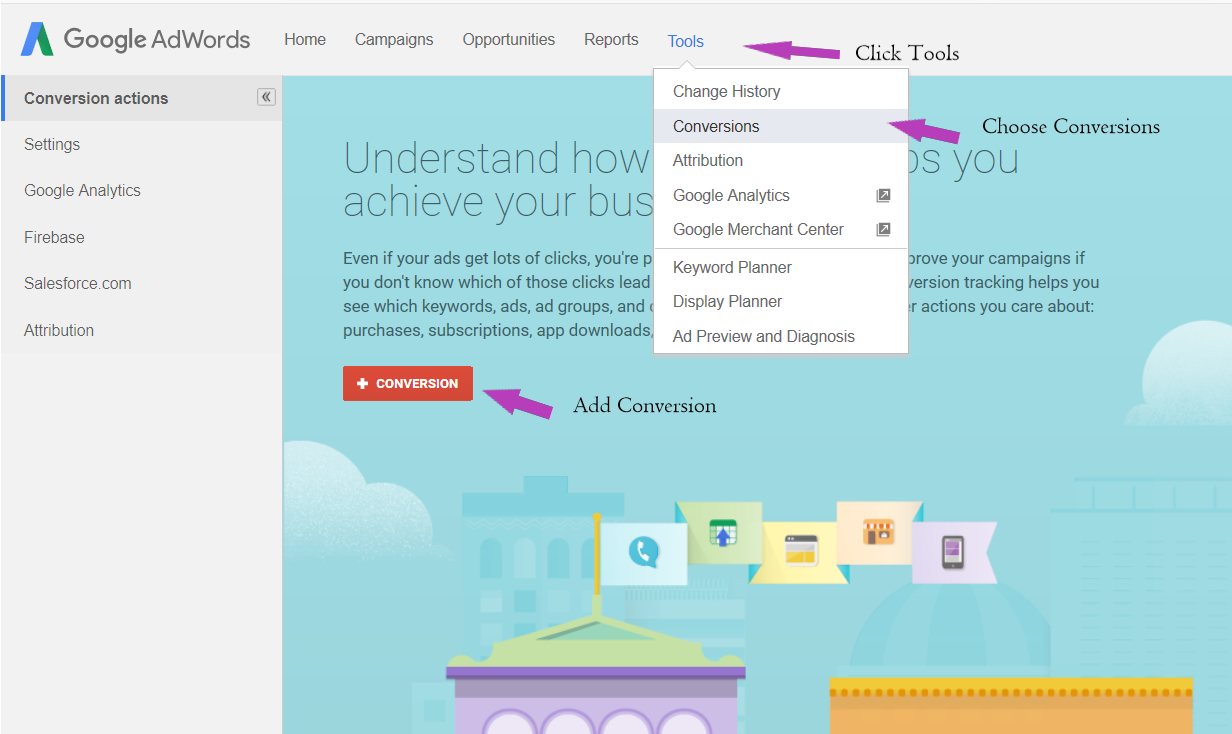
You have different source options to track the conversions, from your website, from apps, from phone calls or to import. Just select the appropriate option and follow the indications to add the conversion. To finalize the conversion tracking procedure, you need to insert a conversion code on your site.
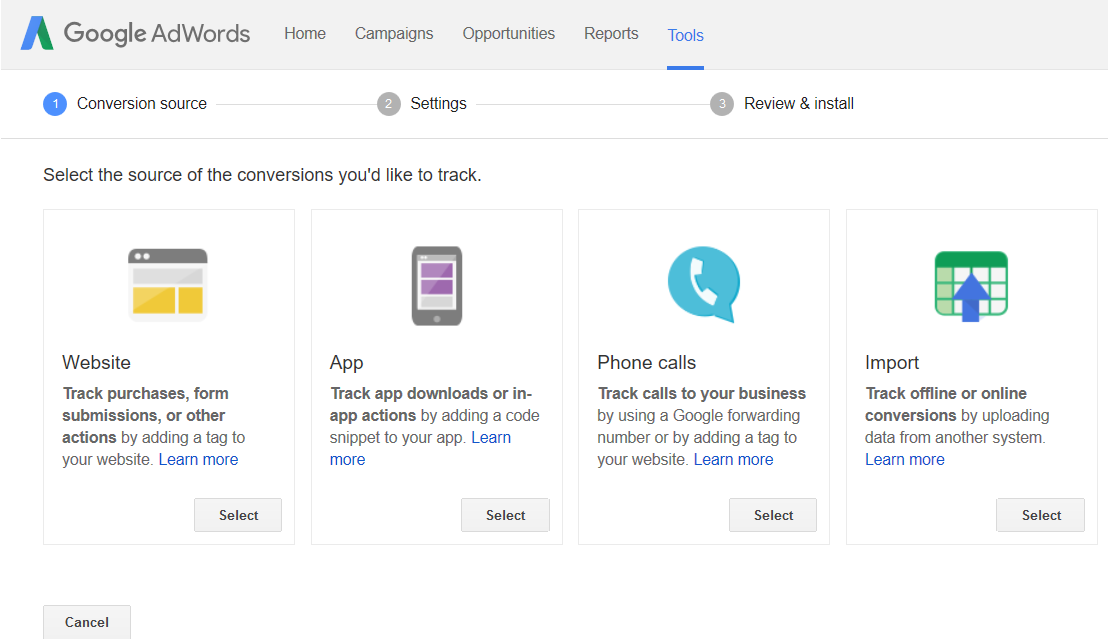
Google Display Ads Tutorial: How to Set Up Google Display Ads
To practically create the campaign for the Google Display Network you need to follow several steps:
· Click on “Campaigns” in the bar menu
· Click on the red button “+Campaign”
· Choose “Display Network” from the drop-down menu
· Give a title to your campaign
· Choose “No marketing objective > All features” to have all the features available
· Set the right parameters
Among the most important parameters to set we count the:
· Geographic area to target
· Budget and bids – opt for “Manual CPC” and “Enable Enhanced CPC” to have maximum control over your bidding and still take advantage of Google’s functionality that employs the historical conversion data. You also have the possibility to set your daily budget spent on ads.
· Ad delivery – the “Advanced settings” menu allows you to choose “rotate indefinitely”, a function that permits split testing of the copy of your ads. Define the “frequency cap”, so your ads are not shown several times to the same user at a certain moment in time.
· Define your ad groups with different targeting options.
· Set the bid – initially use the information you got from Display Planner, after that adjust based on the results obtained
· Set the targeting criteria already established above
· Insert your ads – start with text ads first and use several versions to identify the highest performer
· Choose the device where your ads will be displayed from the Settings menu
Now your ads are ready to go live!
Remember to always test and improve your campaigns. Constantly review your results, check ad performance, landing page performance, targeting and adjust accordingly.
To ensure your ads success in the long run you have to optimize and improve them continuously.
In practice, just a small part of your ads will be responsible for the major part of results. Pareto principle applies in ads world also: 80% of results are brought by 20% of ads. You should concentrate your efforts just on those ads that bring you the best results and returns.
Google AdWords Display Advertising is the best option to enhance performance via paid traffic, for businesses that cannot face the competition on the search network.
To have a rough idea about the results you should expect from paid advertising, check the infographic realized by WordStream with industry benchmarks:
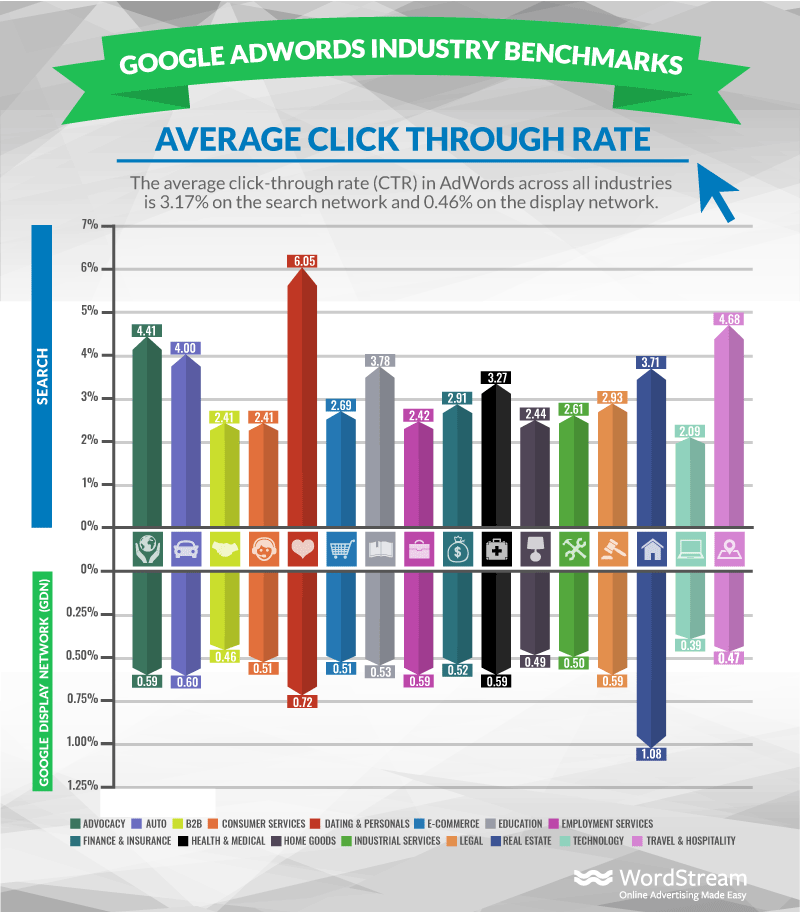
“The average click-through rate in AdWords across all industries is 3.17% for search and 0.46% for display”
The opportunities offered by Google Display Advertising are monumental, but to get significant results you should always be up to date with the Google Display ads’ best practices and implement continuous testing and improving process.


